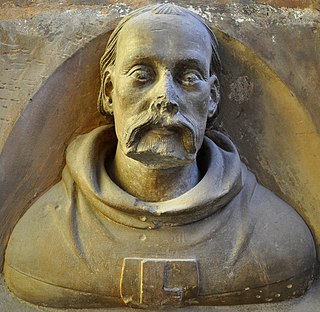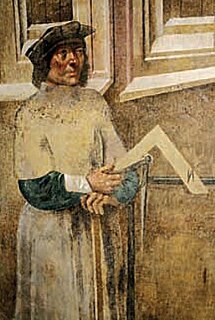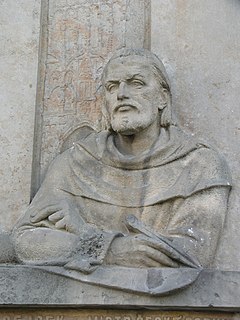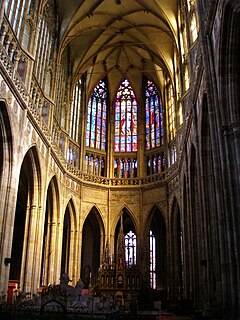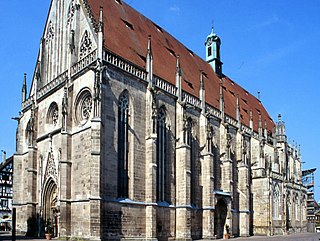
Johann Parler the Younger (Czech : Jan Parléř, German : Johann Parler der Jüngere, [ˈjan ˈparlɛːr̝̊] ; c. 1359 – 1405/06), was a Bohemian architect of German origin from the prominent Parler family of architects, master builders, and sculptors. He was the son of famous Gothic architect Peter Parler, the builder of Saint Vitus Cathedral and Charles Bridge in Prague. His uncle (i.e. Peter’s brother) was Johannes von Gmünd also known as Johann Parler the Elder, a German Gothic master builder who was architect of Freiburg Minster and also rebuilt the damaged Basel Minster.

Czech, historically also Bohemian, is a West Slavic language of the Czech–Slovak group. Spoken by over 10 million people, it serves as the official language of the Czech Republic. Czech is closely related to Slovak, to the point of mutual intelligibility to a very high degree. Like other Slavic languages, Czech is a fusional language with a rich system of morphology and relatively flexible word order. Its vocabulary has been extensively influenced by Latin and German.

German is a West Germanic language that is mainly spoken in Central Europe. It is the most widely spoken and official or co-official language in Germany, Austria, Switzerland, South Tyrol (Italy), the German-speaking Community of Belgium, and Liechtenstein. It is also one of the three official languages of Luxembourg and a co-official language in the Opole Voivodeship in Poland. The languages which are most similar to German are the other members of the West Germanic language branch: Afrikaans, Dutch, English, the Frisian languages, Low German/Low Saxon, Luxembourgish, and Yiddish. There are also strong similarities in vocabulary with Danish, Norwegian and Swedish, although those belong to the North Germanic group. German is the second most widely spoken Germanic language, after English.
A Bohemian is a resident of Bohemia, a region of the Czech Republic or the former Kingdom of Bohemia, a region of the former Crown of Bohemia. In English, the word "Bohemian" was used to denote the Czech people as well as the Czech language before the word "Czech" became prevalent in the early 20th century.
Contents
Johann Parler was born in Prague where he received his education. He worked alongside is father and older brother Wenzel Parler on St. Vitus. In 1398, he is first mentioned as the cathedral's master builder (German : Dombaumeister). After his father died in 1399, Johann continued work on St. Vitus Cathedral. He oversaw construction of the South Tower and was probably the designer of the tracery balustrade, which completes the facade. [1]
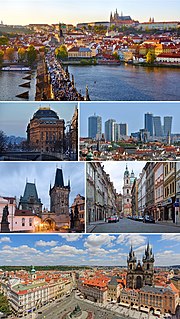
Prague is the capital and largest city in the Czech Republic, the 14th largest city in the European Union and the historical capital of Bohemia. Situated in the north-west of the country on the Vltava river, the city is home to about 1.3 million people, while its metropolitan area is estimated to have a population of 2.6 million. The city has a temperate climate, with warm summers and chilly winters.
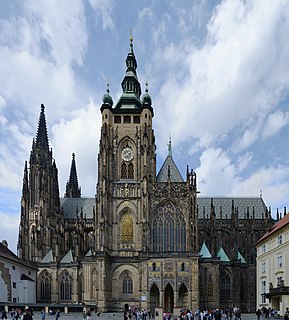
Wenzel Parler was an architect and sculptor from the Parler family of German-Bohemian master builders and son of Peter Parler. He worked on Gothic churches in the Holy Roman cities of Prague, Nördlingen, and Vienna during the Late Middle Ages.
He then moved to Kutná Hora (German : Kuttenburg), where he became master builder of St. Barbara's Church. He was the first architect of the church, construction of which had already been started in 1388 but interrupted. [2] He is the principal designer of the choir. The design of the closed wall that surrounds the choir chapels and the triangular buttresses standing in the central axis clearly follow the Parler family tradition, which became known as the "Parler style." The late Gothic Cathedral is now listed as a UNESCO World Heritage Site. [3]
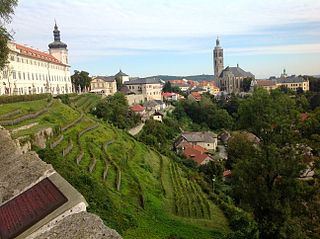
Kutná Hora is a town in the Central Bohemian Region of the Czech Republic.

Saint Barbara's Church is a Roman Catholic church in Kutná Hora (Bohemia) in the style of a cathedral, and is sometimes referred to as the Cathedral of St Barbara. It is one of the most famous Gothic churches in central Europe and it is a UNESCO world heritage site. St Barbara is the patron saint of miners, which was highly appropriate for a town whose wealth was based entirely upon its silver mines.
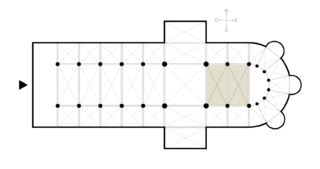
A choir, also sometimes called quire, is the area of a church or cathedral that provides seating for the clergy and church choir. It is in the western part of the chancel, between the nave and the sanctuary, which houses the altar and Church tabernacle. In larger medieval churches it contained choir-stalls, seating aligned with the side of the church, so at right-angles to the seating for the congregation in the nave. Smaller medieval churches may not have a choir in the architectural sense at all, and they are often lacking in churches built by all denominations after the Protestant Reformation, though the Gothic Revival revived them as a distinct feature.




